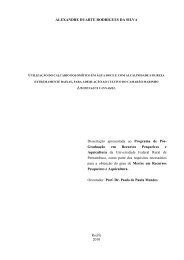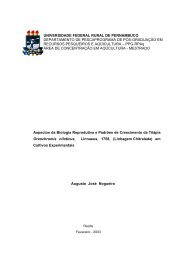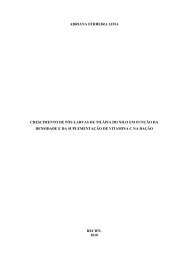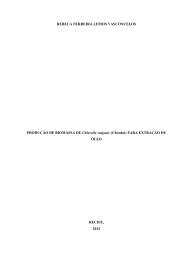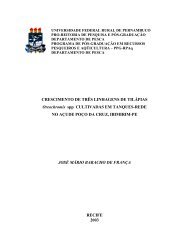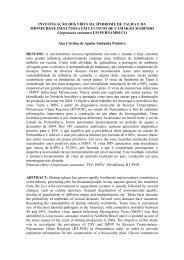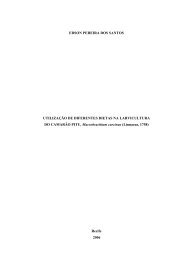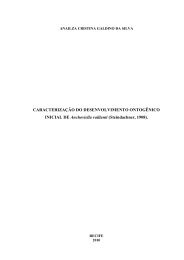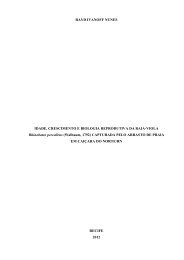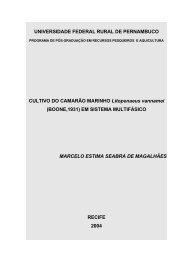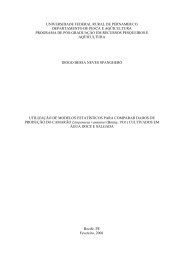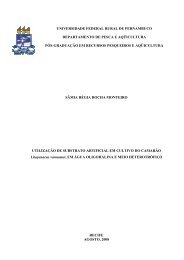XÃLEN FARIA WAMBACH INFLUÃNCIA DE ... - Pgpa.ufrpe.br
XÃLEN FARIA WAMBACH INFLUÃNCIA DE ... - Pgpa.ufrpe.br
XÃLEN FARIA WAMBACH INFLUÃNCIA DE ... - Pgpa.ufrpe.br
Create successful ePaper yourself
Turn your PDF publications into a flip-book with our unique Google optimized e-Paper software.
Abstract<<strong>br</strong> />
Among alternatives of aquaculture production with limited water use for fish farming, the<<strong>br</strong> />
biofloc technology of densities with good production results. Thus, the present study<<strong>br</strong> />
evaluated different stocking densities with biofloc technology, in the nursery and growout<<strong>br</strong> />
phases of Nile tilapia Oreochromis niloticus. The nursery phase lasted 67 days and the tanks<<strong>br</strong> />
were stocked with fingerlings (5.71 g) of tilapia sexually reversed. Treatments consisted of<<strong>br</strong> />
three different stocking densities, with three replicates: 1) D200 (200 fishes.m -3 ); 2) D350<<strong>br</strong> />
(350 fishes.m -3 ) and 3) D500 (500 fishes.m -3 ). The water quality variables showed no<<strong>br</strong> />
significant difference among treatments (P ≥ 0.05). The best performance was obtained at<<strong>br</strong> />
density of 200 fishes.m -3 , with a weight gain of 69.47 g, specific growth rate of 3.71%.day -1 ,<<strong>br</strong> />
feed conversion ratio of 1.20 and survival of 82.62%. Growout phase lasted 128 days and the<<strong>br</strong> />
tanks were stocked with juveniles (123.3 g) of tilapia using three treatments and four<<strong>br</strong> />
replicates involving different stocking densities: 1) D15 (15 fishes.m -3 ); 2) D30 (30 fishes.m -3 )<<strong>br</strong> />
and 3) D45 (45 fishes.m -3 ). The best performance was obtained in the density of 45 fishes.m -3 ,<<strong>br</strong> />
with final weight of 404.37 g, specific growth rate of 0.93%. day -1 , survival of 90.97% and<<strong>br</strong> />
feed conversion ratio of 1.6. The use of bioflocs technology presents by itself as a good choice<<strong>br</strong> />
for tilapia intensive production, besides to being a compatible technique with the principles of<<strong>br</strong> />
sustainability, make possible the stocking and productivity of 200 fishes.m -3 with 12.44 Kg.m -<<strong>br</strong> />
3 , and 45 fishes.m -3 with 16.57 Kg.m -3 , respectively for nursery and growout phases.<<strong>br</strong> />
Key words: fish culture, Nile tilapia, stocking density, zootechnical performance.



